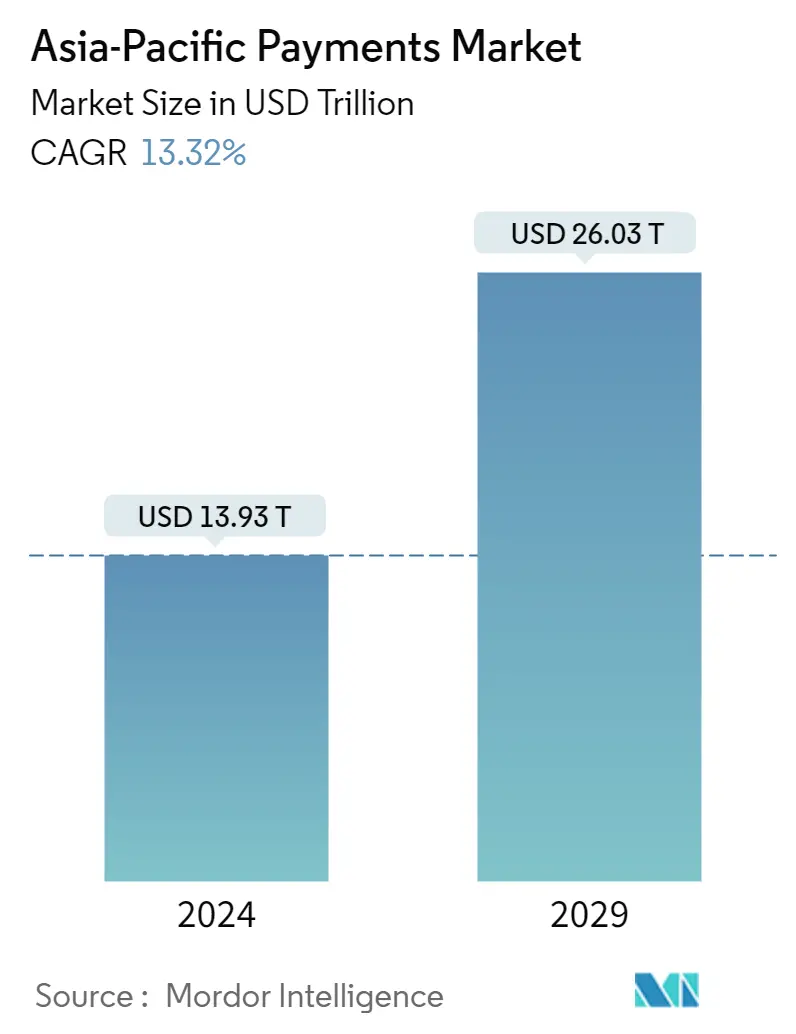Market Size of Asia-Pacific Payments Industry

| Study Period | 2019 - 2029 |
| Base Year For Estimation | 2023 |
| Market Size (2024) | USD 13.93 Trillion |
| Market Size (2029) | USD 26.03 Trillion |
| CAGR (2024 - 2029) | 13.32 % |
| Market Concentration | Low |
Major Players
*Disclaimer: Major Players sorted in no particular order |
APAC Payments Market Analysis
The Asia-Pacific Payments Market size is estimated at USD 13.93 trillion in 2024, and is expected to reach USD 26.03 trillion by 2029, growing at a CAGR of 13.32% during the forecast period (2024-2029).
- In Asia-Pacific, consumers are increasingly moving to contactless and electronic payments. They continue to move away from using cash. The main reason for this change is the incredible speed at which payment technology is evolving in the region.
- In emerging and developing regions such as the Asia Pacific, mobile payments have grown tremendously due to the ease of transactions, the widespread use of smartphones, and the financial inclusion capabilities of technology.
- With the spread of smartphones and the Internet, the adoption of mobile wallets has been accelerating over the years. China and India now make up more than 50% of the world's smartphone population, making e-Wallet use the mainstream. They provide convenience and security for payment processing and are currently at the forefront of payment changes. Additionally, the unique characteristics of the payment environment in the Asia-Pacific region are that the government is actively pursuing policies that encourage cashless payments.
- However, data privacy remains a big challenge for mobile phone applications providing payment services. Companies continuously attempt to create simpler and safer methods of authenticating their clients' identities, increasing their policies' safety and dependability. Some companies look forward to integrating official papers like driver's licenses to verify users and avoid fraudulent accounts. Such measures help to strengthen mobile payments.
- •During the COVID-19 pandemic, digital payments accelerated in the Asia-Pacific region. Physical or contactless cards and digital wallets were the most common payment methods during the pandemic, but in some countries, during the Covid-19 pandemic cash remained the primary payment method. Further, to seamlessly transition to mobile payments, which may be an integral part of the more digital post-COVID-19 world, the Asian economies are poised to strengthen their regulatory frameworks and invest in digital networks and infrastructure, such as those enabling the usage of digital IDs.
APAC Payments Industry Segmentation
The scope of the study tracks transactions generated at offline (POS) physical stores and online (E-commerce/digital) channels in Asia-Pacific. Online payments include online purchases of goods and services, such as purchases on e-commerce websites and online bookings for travel and accommodation. However, they do not include online purchases of motor vehicles, real estate, utility bills (such as water, heating, and electricity), mortgage payments, loans, credit card bills, or purchases of shares and bonds. In the offline segment, all transactions at the physical point of sale are included in the market scope. It includes traditional in-store and face-to-face transactions, regardless of where they occur. Cash is also considered for both cases (cash on delivery for e-commerce sales).
The Asia-Pacific Payments Market is Segmented by Mode of Payment (Offline/Point of Sale (Card Payments, Digital Wallets, Cash), Online Sale/E-commerce (Card Payments, Digital Wallet)), End-user Industries (Retail, Entertainment, Healthcare, Hospitality), and Country (China, India, South Korea, Taiwan, Singapore, Philippines, Malaysia, Indonesia, Vietnam, Australia, and Japan).
The market sizes and forecasts are provided in terms of value (USD) for all the above segments.
| By Mode of Payment | ||||||
| ||||||
|
| By End-user Industry | |
| Retail | |
| Entertainment | |
| Healthcare | |
| Hospitality | |
| Other End-user Industries |
| By Country | |
| China | |
| India | |
| South Korea | |
| Taiwan | |
| Singapore | |
| Philippines | |
| Malaysia | |
| Indonesia | |
| Vietnam | |
| Australia | |
| Japan |
Asia-Pacific Payments Market Size Summary
The Asia-Pacific payments market is experiencing significant transformation, driven by the rapid adoption of digital and mobile payment solutions. As consumers increasingly shift towards contactless and electronic payment methods, the region is witnessing a substantial decline in cash usage. This shift is largely attributed to the swift advancements in payment technology and the widespread penetration of smartphones, which have facilitated the growth of mobile payments. Countries like China and India are at the forefront of this movement, with e-wallets becoming mainstream due to their convenience and security. Government initiatives across the region are also promoting cashless transactions, further accelerating the transition to digital payment systems. However, challenges such as data privacy and security remain critical concerns, prompting companies to innovate in identity verification and fraud prevention.
The market landscape is characterized by intense competition, with major players like Visa, Mastercard, and Samsung Pay expanding their presence through strategic partnerships and technological innovations. The COVID-19 pandemic has acted as a catalyst, significantly boosting the demand for digital payments as consumers sought safer transaction methods. In countries like Malaysia, the government and financial institutions are actively working to enhance digital infrastructure and regulatory frameworks to support the growing digital economy. The rise of e-commerce and the O2O market has further fueled the adoption of mobile payments, with digital wallets expected to dominate e-commerce transactions in the coming years. As the region moves towards a more digital future, the payments market is poised for continued growth, driven by technological advancements and changing consumer preferences.
Asia-Pacific Payments Market Size - Table of Contents
-
1. MARKET INSIGHTS
-
1.1 Market Overview
-
1.2 Industry Stakeholder Analysis
-
1.3 Industry Attractiveness- Porter's Five Forces Analysis'
-
1.3.1 Bargaining Power of Suppliers
-
1.3.2 Bargaining Power of Buyers/Consumers
-
1.3.3 Threat of New Entrants
-
1.3.4 Threat of Substitute Products
-
1.3.5 Intensity of Competitive Rivalry
-
-
1.4 Evolution of the payments landscape in the region
-
1.5 Assessment of Impact of COVID-19 on the Market
-
1.6 Analysis of Growing Payment Fraud in Asia-Pacific and its Impact on the Payments Market
-
-
2. MARKET SEGMENTATION
-
2.1 By Mode of Payment
-
2.1.1 Offline (Point of Sale)
-
2.1.1.1 Card Payments (includes debit cards, credit cards, and bank financing prepaid cards)
-
2.1.1.2 Digital Wallets (includes mobile wallets)
-
2.1.1.3 Cash
-
2.1.1.4 Other Modes of Payment
-
-
2.1.2 Online Sale (E-commerce)
-
2.1.2.1 Card Payments (includes debit cards, credit cards, and bank financing prepaid cards)
-
2.1.2.2 Digital Wallets (includes mobile wallets)
-
2.1.2.3 Other Modes of Payment (Includes cash on delivery, bank transfer, and buy now pay later)
-
-
-
2.2 By End-user Industry
-
2.2.1 Retail
-
2.2.2 Entertainment
-
2.2.3 Healthcare
-
2.2.4 Hospitality
-
2.2.5 Other End-user Industries
-
-
2.3 By Country
-
2.3.1 China
-
2.3.2 India
-
2.3.3 South Korea
-
2.3.4 Taiwan
-
2.3.5 Singapore
-
2.3.6 Philippines
-
2.3.7 Malaysia
-
2.3.8 Indonesia
-
2.3.9 Vietnam
-
2.3.10 Australia
-
2.3.11 Japan
-
-
Asia-Pacific Payments Market Size FAQs
How big is the Asia-Pacific Payments Market?
The Asia-Pacific Payments Market size is expected to reach USD 13.93 trillion in 2024 and grow at a CAGR of 13.32% to reach USD 26.03 trillion by 2029.
What is the current Asia-Pacific Payments Market size?
In 2024, the Asia-Pacific Payments Market size is expected to reach USD 13.93 trillion.

